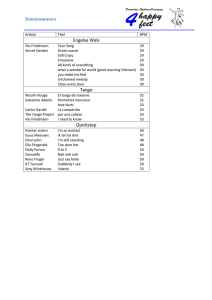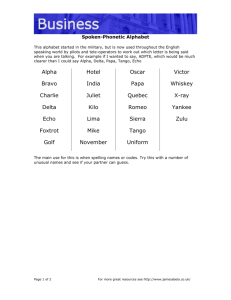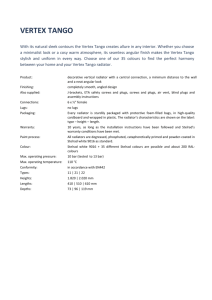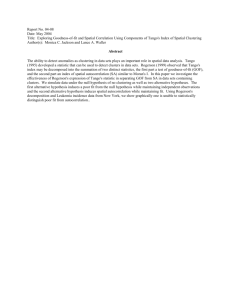Ko, Michelle - The Spirit of Great Oak
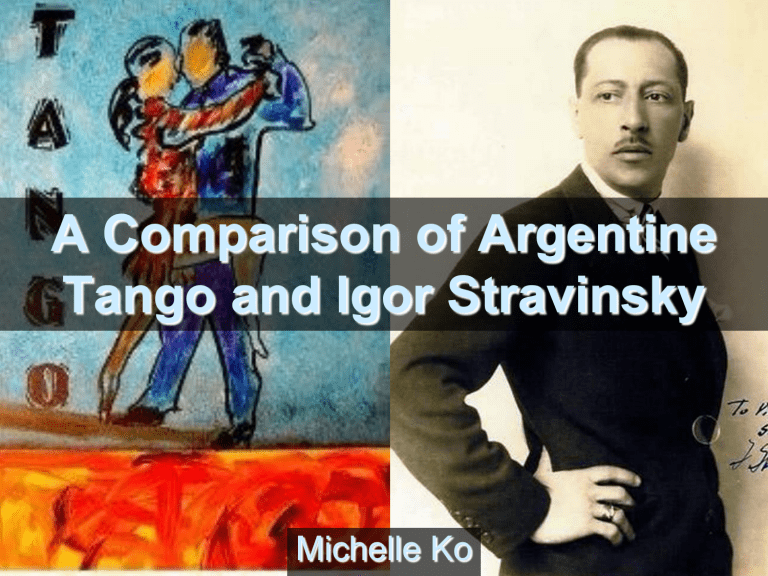
A Comparison of Argentine
Tango and Igor Stravinsky
Michelle Ko
Argentina Demographic
Capital: Buenos Aires
Size: 2,780,400 sq km
Population: 41,769,726 (2011)
Ethnicity: white (mostly Spanish and Italian) 97%, mestizo (mixed white and Amerindian ancestry),
Amerindian, or other non-white groups 3%
Religion: Roman Catholic 92%,
Protestant 2%, Jewish 2%, other
4%
History of Tango
Earliest evidence of Tango dates back to the mid nineteenth century in Buenos Aires
Around the turn of the century, many
European immigrants arrived at Buenos
Aires
They brought with them a more lyrical style of violin playing, and the melodic influence of Neapolitan song, a key factor in the melodic beauty characteristic of Tango
Around the year 1910, it is claimed that
Bandoneóns were brought to Argentina by
German immigrants
The dance that was associated with the
Tango music became a driving force in introducing the music to the world
Bandone ón
g
History of Tango cont.-
Nuevo Tango
In the late 1940s, the music and the dance started to separate
Musicians were more interested in playing for a concert audience
In 1955, nationalistic government that encouraged
Tango was replaced by a new regime that discouraged Tango
Many artists were blacklisted or imprisoned
“ New Tango ” was formed by Astor Piazzolla who took elements of Tango but diverted from the tradition
Renewed the interest in dance
Primary Instruments
Bandane
ón
Essential instrument in the tango orchestra
In Germany, it was originally intended to play religious music
Buttons instead of piano keys
More compatible with chromatic tuning structure
Bombo
Luguero
Made of a hollowed tree trunk and covered with cured skins of animals
Serves as a combination of bass and percussion, not just maintaining the meter, but evoking an elemental, visceral response
Erkencho
Transverse horn
Used for ritual purposes
No reed in its mouthpiece
Produces the notes available in the natural harmonic series
El Choclo(1898)-Angel Villoldo
http://www.youtube.com/watch?v=xE7gKEG8O9Y
With Intro: http://www.youtube.com/watch?v=g8YSUUeQhHA&feature=pla yer_embedded#!
Usually played with a
Bandaneón or piano for tango dances
2/4 time
Key: b minor
(Measures 1-8)
Begins with a diminished seventh
Measure 2: Tonic
Structure: A-B-C-A-
B-C (including the introduction
Habanera bass
Dynamics throughout the piece
Key change: d minor (Measures 9-32)
Starts with a pickup: three sixteenth notes
B flat in the melody but does not belong in the d minor chord (D-F-A)
Creates dissonance with bass line and tension
Scattered Rhythm (“Call” and “response”)
Chromatic scale present in the piece
Scattered rhythm pattern (Call and Response)
Key change back to the beginning (b minor)
The tango eventually extended to Europe at the beginning of the 20th century. Its popularity soon spread as musicians and dancers from South America performed it in the European metropolises in the 1910s and 1920s. Gradually, composers in
Europe began writing tangos…
Igor Stravinsky
Russian-born American composer
Born in June 17, 1882 in Oranienbaum, Russia
Biography
Igor Stravinsky grew up in a music atmosphere
His father was a leader bass Mariinsky
Theatre in St Petersburg
Acquired a love for musical theatre at a young age
Never entered a music school or a cons è rvatory, and never earned an academic degree in music.
Stravinsky studied with Rimsky-Korsakov, who was an influence on his early music
Stravinsky ’ s early works impressed Diaghilev
(sponsor of entertainment) and invited him to arrange large scale ballet
Diaghilev remained a supporter/sponsor throughout Stravinsky ’ s life
Prominent Works
Fireworks [Ballet]
Petrushka
The Rite of Spring
The Firebird
Histoire du Soldat (A Soldier’s Tale)
Symphony in Eb Major
Oedipus Rex, opera-oratorio
Tango-Igor Stravinsky
Originally for piano in 1940
Composed for chamber orchestra in 1953
4/4 time
Key: d minor
Minimal dynamics
Chromatic scale present in the piece
Bass leads in
Scattered rhythm http://www.youtube.com/watch?v=WCz-w8-ipG8
Comparisons
El Choclo:
2/4 time
Written for variety of native instruments
Structure: A-B-C-A-B-C
Wide range of dynamics
Key changes throughout
Similarities:
Key of d minor
Both chromatic scales leads into repetition of the pattern
Similar melodic rhythm
Beat is sharp allowing it to be a dance music
Scattered rhythms
Tango:
4/4 time
Written for piano
Structure: Bass lead in
Minimal dynamics
Work Cited
https://www.cia.gov/library/publications/the-worldfactbook/geos/ar.html
http://www.carnegiehall.org/BlogPost.aspx?id=4294982543
http://www.totaltango.com/acatalog/tango_brief_intro_91.html
http://www.notablebiographies.com/St-Tr/Stravinsky-Igor.html
http://latinmusic.about.com/od/playlists/tp/TangoDanceSongs.htm
